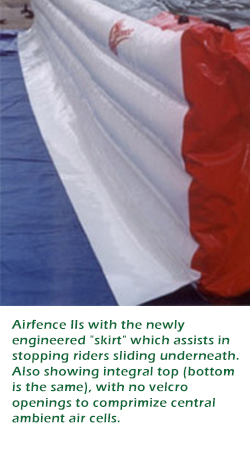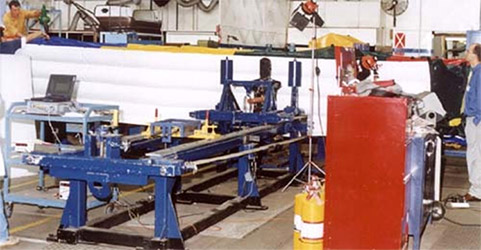Airfence IIs is for you if
- you have only a couple of bike track days a year
- you are a street circuit
- you promote races at different locations
- compact storage is a priority
The work of absorbing impact is done by the inflated frame and the normal air pressure cells which build up pressure to increasingly decelerate the rider. These cells also exhaust regulated air to ensure that pressures do not build up excessively to create sudden deceleration and injure the rider. They also stop “rebound” where a rider could be thrown back on to the track in front of other riders.
For the situation of multiple accidents, for instance where oil is spilt on the track and a number of riders crash, Airfence IIs is designed to very quickly resume it’s shape and be ready for further impacts almost immediately the first rider gets off the Airfence.
Unlike some imitations of Airfence IIs, our safety system has key features to ensure it’s reliable performance:
- joining straps using seat belt webbing and D rings forming the strongest joint.
- 950 gsm inflatable boat fabric for our inflated cushions to give greater resistance to puncture and tearing
- conveyor belt “skirt” to help stop riders sliding underneath
- integrally strong central air cells with no potentially weak hook and loop flaps

AIRFENCE IIS – INSTALLATION
To install your barrier, simply deliver the required number of modules to the locations on your track, unwrap and then unroll them. They are easy to lift with handles fitted to both wrapper and module. The Airfence module is then inflated using a fan-blower to pump air into the 5 cushions of each section. Front and back cushions have their own inflation valve and pressure relief valves. It takes about 5 minutes to inflate each module.
First the front and back cushions are inflated with the module lying down. Then it’s easiest to stand the Airfence module up and inflate the three central “separator” cushions. Once inflated, the module is simply lifted into place, fastened top and bottom to adjacent modules and tied off to the wall via the fastening points on the Airfence. Make sure the front skirt is facing outwards and presto! you have the best safety barrier available. What’s more it is easily removed again for car racing, avoiding expensive damage.
Durable?
Repairable?
Of course sometimes it does happen that an Airfence module is hit hard enough to be damaged. But it is easily repairable using adhesives and patches of material that are supplied to you when you invest in Airfence safety. We even show you how to do it when we come to first install your Airfence safety system with you. The module can be repaired time and again if required, though this is highly unlikely. Any parts needed are available and can be replaced. Airfence also offer an ongoing inspection, repair and management service. You must use the correct adhesive.

AIRFENCE IIS UNDERGOING ACCREDITATION TESTING AT ONE OF FORD’S R&D PLANTS.
Airfence products are made from heavy duty, reinforced PVC fabric that is extremely strong yet flexible and highly UV stabilized. This means that you can happily leave it in the sun for many years without it degrading. Of course, it’s fire retardant too. So you will be using a safe product for your track staff and one that will last.

An Airfence IIs safety system is made up of sections strapped together so it can be any length and suit any corner. Each section consists of front and back cushions, separating cushions dividing the front from the back, and normal or ambient air pressure cells. All the cushions are lightly inflated to approximately 0.3 psi and these create the frame and cells to stand the Airfence up and hold it’s shape. Pressure relief valves are fitted to the cushions to regulate the air pressure. The modules have angled ends so that they overlap.


